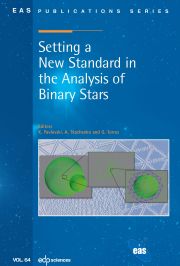No CrossRef data available.
Article contents
Radio Afterglow of the Jetted Tidal Disruption EventSwift J1644+57
Published online by Cambridge University Press: 22 July 2013
Abstract
The recent transient event Swift J1644+57 has been interpreted as resulting from arelativistic outflow, powered by the accretion of a tidally disrupted star onto asupermassive black hole. This discovery of a new class of relativistic transients opensnew windows into the study of tidal disruption events (TDEs) and offers a unique probe ofthe physics of relativistic jet formation and the conditions in the centers of distantquiescent galaxies. Unlike the rapidly-varying γ/X-ray emission fromSwift J1644+57, the radio emission varies more slowly and is well modeled as synchrotronradiation from the shock interaction between the jet and the gaseous circumnuclear medium(CNM). Early after the onset of the jet, a reverse shock propagates through anddecelerates the ejecta released during the first few days of activity, while at much latertimes the outflow approaches the self-similar evolution of Blandford and McKee. The pointat which the reverse shock entirely crosses the earliest ejecta is clearly observed as anachromatic break in the radio light curve at t ≈ 10 days. I discuss theimplications of Swift J1644+57 for the fraction of TDEs accompanied by relativistic jets;the physics of jet formation more broadly; and the prospects for detecting off-axis TDEradio emission, either via follow-up observations of TDE candidates discovered at otherwavelengths or blindly with upcoming wide-field radio surveys.
- Type
- Research Article
- Information
- Copyright
- © EAS, EDP Sciences 2013


